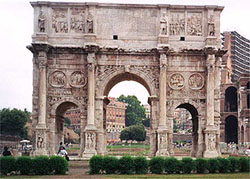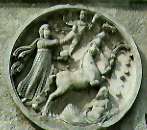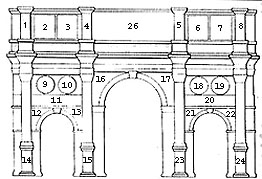|
.:: Ubi's Rome ::.
made in UbiLand |
|
|
Arch of Constantine The Arch of Constantine ("Arco di Costantino") is situated in piazza del Colosseo ("Coliseum Square"), at the entrance of the ancient Via Trionfale where were bestowed honours to generals and victorious emperors; restored in 1981-1987, has around: the Coliseum, the Neronian remains of the Domus Aurea, the vestiges of the temple of Venus and Rome and one fifth of the Palatine.  the Arch of Constantine This extraordinary arch, the most imponent and the best preserved amongst the surviving Roman arches, seems the only one to be coherent with itself, but with at a closer look one can notice the heterogeneity of its parts and of the single sculptured components. It has been built with the assent of the Senate and of the People in 314 A.D., for the decennial of the emperor and to celebrate the victory of Constantine over Maxentius at Ponte Milvio (Ponte = "Bridge") which happened three years before. Constantine insisted saying that the victory was due to a vision of Christ. The Arch was made using fragments of edifices of more ancient ages, particularly the more beautiful reliefs were taken from the monuments of the time of Trajan and Adrian (emperors "Traiano" and "Adriano", in Italian), illustrating the achievements of these emperors (so much that some scholars maintain that its origin would be in one of these periods and that Constantine would only have it modified). They are, in fact, precedent to Constantine, the statues of barberians high placed, the great battle frieze divided in four parts, the very beautiful lowreliefs of the attic, the medallions with hunting sceneries and sacrifices to divinities, these last ones surely of Adrian's time.  a round medallion-relief on the Arch of Constantine Even the Corinthian columns and the entablatures have probably a far origin. Naturally there is no shortage of parts in which Constantine is represented. He is shown while speaking to the people or in the conquest of a ciy. In these one can see the difference of the late ancient style as regards the late golden imperial period. This Arch, in its heterogeneity, is an example of a frequent praxis in the IV century: stripping the ancient temples of statues and sculptures and using again these last ones to set up new monuments. This procedures has thus allowed these works of arts to reach us, works which otherwise would probably have been destroyed. In the Middle-Ages it was incorporated in the fortresses of the Frangipane, and were restored in the XVIII century and liberated in 1804. It sports three barrel vaults and free columns of Numidian marble on the facade, it was partly decorated with despoiled reliefs and sculptures: the statues of the barbarian prisoners, on the top of the columns, and the frieze on the sides of the attic and inside the central barrel vaults, are trajanious; the circles over the barrel vaults are adrianian, the reliefs in the barrel vault, at the side of the incription, are aurelian. The reliefs, made at Constantine time, present allegorical figures, a somewhat classical outline which is worn out; the historical ones, instead, are expression of the stereometrical taste of that time.  numbered parts of the Arch of Constantine This is what can be seen on the Arch: NORTH FACADE (towards the Coliseum)
SOUTH FACADE (towards via San Gregorio)
|
|
